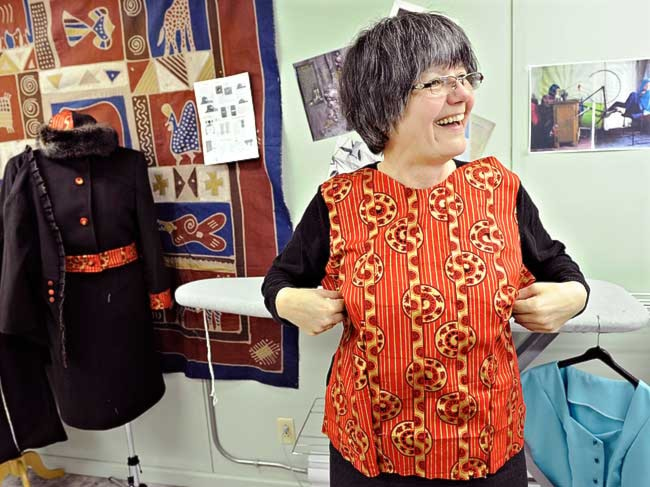Jessica Vellenga - like most women - is rarely satisfied with what store clothing racks have on offer.
Maybe a little hem here, a tailor tuck there, different pockets and buttons, even a new collar - only then would the garment be perfect.
But, unlike most women, Vellenga actually does the alterations.
“I’ve been sewing since I was a kid,” she says through the window created between the arm and presser foot of one of Yukon College’s sewing machines. “I’m big on recycling and reusing and I’ve always preferred redesign.”
Squashed in a narrow trailer classroom, parked near the back of the college’s main building, Vellenga and Kim Hudson sit back to back.
Hudson is slouching over what will soon be her latest creation.
She is pinning a sheer accent material along edges of a black dress she found at a used-clothing store.
Before taking this clothing redesign course at the college, Hudson described herself as “not much of a sewer.”
But the dress she is working on will be the seventh piece in a growing collection of redesigned outfits she’s made during the course.
“I love it,” she says, looking up with her back still arched over the clutter of material. “The experience of wearing clothes that fit you, it changes how you face the world, really. Suddenly, you’re meant to fit in it. It’s a wonderful feeling - both in style and shape.”
The continuing education course began with one jacket: a brown, cashmere-wool blend that cost $4 at Liquidation World. Instructor Lea-Ann Dorval bought one for each student and made sure they were as big as she could get them to allow for the most leftover material.
The assignment seemed simple enough. Each student had to turn the jacket into something else.
One student made a jacket that looked completely different than the original. Another created a skirt, blazer and hat combination while Hudson fashioned two dresses - one casual, one dressy.
When Dorval first offered a basic sewing course at the college, she had space for ten people - 120 applied.
“There’s definitely a big demand,” she says. But this is the first time she has offered a redesign course.
“I’ve been wanting to do a course like this for a while,” says Dorval. “It’s not a new idea. There are lots and lots of people out there nowadays that are doing stuff like this - there’s hasn’t been anyone offering it here. But most of these students, actually, have been fooling around, doing it on their own before they took the course. Particularly up here, because we’re limited with what we can buy, and what materials to work with.”
The sewing skills and experience of the eight women who took the course vary as much as their final pieces. Some brought in outfits that just needed simple tailoring, others turned Salvation Army finds into totally new creations.
The goal, for Dorval, is to help instill the assurance in these women that they can go out and do this again and again on their own.
“With any course that I teach I hope my students will go home and feel confident enough to carry on,” she says. “I want them to walk away with that kind of confidence. Some of them arrived with that confidence, but that’s probably the biggest thing for me, that they go home and feel comfortable. Particularly in areas they didn’t before.”
Still, Dorval is accustomed to phone calls and visits from past students looking for that expert glance over their shoulder, she says with a laugh.
And for most of the women, talking over the murmur of sewing machines in the cramped trailer, this course is only a beginning.
“This type of sewing and redesigning is a good framework for a little business,” says Dorval. “It’s so popular, people like redesigned things.”
Vellenga is well aware of that fact.
She has been using skills she learned in high school home economics classes to not only dress herself with redesigned finds, but also create and sell some things at small craft fairs.
She heard about Dorval from a friend that encouraged her to do more.
Originally seeking one-on-one tutoring, Vellenga found out about this course.
Now, that humongous stash of material and outfits in need of redesign that she has collected over the years will slowly become smaller, says Vellenga.
And she is looking at selling what she makes, both locally and online.
Vellenga has also toyed with the idea of starting a collective with other women in the community who share her passion to take what is on the rack and create a well-fitting, original piece.
“I’ve always done it and people have always said, ‘Oh, that looks great,’” she says. “But for me, taking this course was really a way for me to take it to the next level.”
Contact Roxanne Stasyszyn at
roxannes@yukon-news.com
